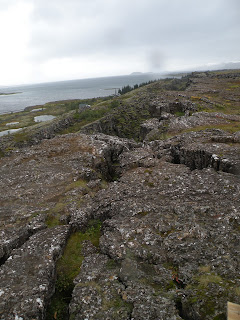Iceland - September 2015
Hello and welcome to our first photo-blog post in a very long time! Almost two years! We haven't had a lot of time to do any posts, due to all of the house renovations and other jobs that come along with life. But we think we have most of the house finally finished (unless we decide to move it 6 inches to the left, or turn it around), so we can enjoy the house for a while and not work on it.
John had earned a sabbatical at work, and we had been planning a trip to France for quite a while. We found some great ticket prices on Icelandair, and a friend of Annie's told us that if you flew Icelandair, you could get a free stopover in Reykjavik. That's all it took! We carved out 3 days from our trip to France and stopped off in Iceland. The picture above is one of the iconic images of Iceland. It is the Sun Voyager sculpture and it sits in the Reykjavik harbor, representing the seafaring spirit of Iceland - although all of the European countries who were raided by the Vikings may not have the same warm fuzzy feelings!
Iceland is a pretty small country, population-wise. About 330,000 people total and 180,000 of those live in Reykjavik, according to our tour bus driver.
One the Icelandair flight, the entertainment system will show certain facts about Iceland, if you leave that channel on. Things like "It's not surprising that Iceland is the most "wired" country in the world, with 97% of the people having Internet access. The most surprising thing is that 75% of the people believe in fairies and trolls". So there are a few opportunities to take pictures with trolls!
Another iconic image of Iceland and Reykjavik - the Hallgrimskirkja - a Lutheran church in Reykjavik. This was the view out of our Hotel. It's a gorgeous church, inside and out. Now for a little trivia - it's even been in a Simpsons episode!
These are pictures from the Simpsons episode "The Saga of Carl", that were hanging in the lobby of our hotel (Hotel Leifur Ericsson). You can see the Hallgrimskirkja in the upper picture and below shows the view from the Church. Our hotel is the building on the top right of the lower picture! Yayyy! We stayed somewhere somewhat remotely notorious!
We took a day-long bus tour to do the "Golden Circle". It's a quick tour around some of the scenic spots near Reykjavik. First we stopped at a geothermal plant. The picture above is from a presentation they gave, showing how the mid-Atlantic ridge slices through Iceland, and where the main areas of volcanic activity are. The Icelanders are the world's foremost geothermal engineers, and they are serving as the design engineers for geothermal plants all over the world. Almost all of Iceland's energy comes from geothermal and hydropower.
Okay, now for a pop quiz to see how old everyone is and if they can remember way back in the day. Does anyone remember the James Bond movie "You Only Live Twice" with Sean Connery? The one where he very badly played an Asian? In this movie, the bad guys (probably Spectre) had a rocket launch facility underneath a false lake. When they got ready to launch the rocket, the fake lake top opened up to allow the rockets to launch. Voila! Above is the lake that was used for the outdoor shots in the movie. Amazingly, later in the trip while we were in France, the movie came on French TV and we watched to make sure the bus tour guide was right. And there it was!
This is what you do when you have way too much money, AND you may be experiencing some doubts about your masculinity. You buy a Mercedes Sprinter van and jack it up 5 feet off the ground. We saw this at the Strokkur geothermal area.
Here are two different shots of the Strokkur geyser going off. I put the camera in "action" mode and started squeezing the trigger when I saw the water begin to burst upwards. In the top shot, the geyser is already about 10 feet high.
About 30 pictures later (and 8 seconds later), the geyser topped out at about 80 feet.
After that, we visited the Gulfoss waterfall. It's a huge waterfall caused by a glacier-fed river cutting its way down through the lava beds. It's interesting that it doesn't go straight over the cliffs, but "slides" off to one side and then the other as it works its way downstream. To get an idea of the size of the water falls, you can see people standing to the left of the top waterfall on the cliffs.
The last stop of the tour was the Thingvellir National Park. It's a great area, where the mid-Atlantic ridge is on land, and you can see the cracks as the Eurasian tectonic plate is moving east and the North America plate is moving west. They are spreading apart at about 2 mm (~0.08 inches) per year.
These cracks have been here a long time! They seem to be pretty stable, and walking paths have been built through them for tourists. In fact, Icelanders have used these areas for festivals and meetings for over a thousand years.
It was really a great 3 days in Iceland. We didn't see any northern lights, but you can see from most of our pictures, it was pretty cloudy while we were there. It would be great to go back, and spend about 10 to 14 days and drive the ring road all the way around the country. You could then get out and see the active volcanoes, the glaciers, go whale watching - the whole shebang.
That's all for Iceland. The next post will be on our trip continuing onto France!
John & Annie



























.JPG)


































